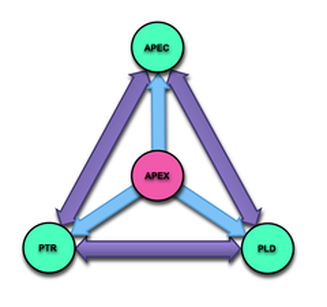NSF Mathematics and Science Partnership

The vision of the Alliance for Physics Excellence (APEX) is to transform secondary physics education in Alabama by enabling physics in-service and pre-service teachers to acquire a deeper knowledge of physics and more effective instructional strategies based on educational research, and also by enabling students to achieve higher levels of learning in their school classrooms.
The three major components of APEX are:
1. The Physics Teacher Institute (PTI) is a multi-year experience offering participants a coherent program of study to deepen their physics Discipline Content Knowledge (DCK) and Pedagogical Content Knowledge (PCK), and to increase their Technological Pedagogical Content Knowledge (TPCK). The Institute develops leadership skills using the Physics Teaching Resource Agent (AAPT/PTRA) Professional Development model. Teachers will be exposed to instructional strategies based on physics education research. An integrated three-dimensional approach will be used that is based on the latest teaching methodologies. Conceptual understanding (CU), problem-solving methods (PS), and hands-on exploration (EX) will be the core of the Institute’s teaching methodologies.
2. The Physics Teaching Research Program (PTR) (University of Alabama role). Physics Teaching Research Program (PTR) goals are to establish, foster, enhance, and sustain project outcomes in teaching and learning through development of a research priority using a community of researchers focusing on physics education. Formal research along with teacher action research verifies effective strategies and extends the knowledge base. Research on physics teaching and classroom action (practitioner) research are essential elements of PTR. The PTR program explores the effectiveness of the APEX professional development model and is designed to create a strong foundation of research on practice contributing new knowledge to be disseminated nationwide. The research program is organized around understanding immediate and long term impacts of different components of PTI on participating pre- and in-service teachers, students, and administrators. The central research question defining the PTR research agenda is:What are the impacts on short- and long-term outcomes of teacher professional development that focuses on the implementation of reform in secondary school physics classrooms?
3. The Physics Leadership Development Program (PLD) provides opportunities for teachers, science curriculum coordinators, principals, and superintendents to understand the role of physics education in participating schools and districts. The success of any curriculum enrichment and professional development initiative is dependent upon the understanding and support of the intellectual leadership provided by all stakeholders. Specifically, the PLD Program aims to involve teachers in every stage of policy making affecting the physics curriculum.
The three major components of APEX are:
1. The Physics Teacher Institute (PTI) is a multi-year experience offering participants a coherent program of study to deepen their physics Discipline Content Knowledge (DCK) and Pedagogical Content Knowledge (PCK), and to increase their Technological Pedagogical Content Knowledge (TPCK). The Institute develops leadership skills using the Physics Teaching Resource Agent (AAPT/PTRA) Professional Development model. Teachers will be exposed to instructional strategies based on physics education research. An integrated three-dimensional approach will be used that is based on the latest teaching methodologies. Conceptual understanding (CU), problem-solving methods (PS), and hands-on exploration (EX) will be the core of the Institute’s teaching methodologies.
2. The Physics Teaching Research Program (PTR) (University of Alabama role). Physics Teaching Research Program (PTR) goals are to establish, foster, enhance, and sustain project outcomes in teaching and learning through development of a research priority using a community of researchers focusing on physics education. Formal research along with teacher action research verifies effective strategies and extends the knowledge base. Research on physics teaching and classroom action (practitioner) research are essential elements of PTR. The PTR program explores the effectiveness of the APEX professional development model and is designed to create a strong foundation of research on practice contributing new knowledge to be disseminated nationwide. The research program is organized around understanding immediate and long term impacts of different components of PTI on participating pre- and in-service teachers, students, and administrators. The central research question defining the PTR research agenda is:What are the impacts on short- and long-term outcomes of teacher professional development that focuses on the implementation of reform in secondary school physics classrooms?
3. The Physics Leadership Development Program (PLD) provides opportunities for teachers, science curriculum coordinators, principals, and superintendents to understand the role of physics education in participating schools and districts. The success of any curriculum enrichment and professional development initiative is dependent upon the understanding and support of the intellectual leadership provided by all stakeholders. Specifically, the PLD Program aims to involve teachers in every stage of policy making affecting the physics curriculum.

